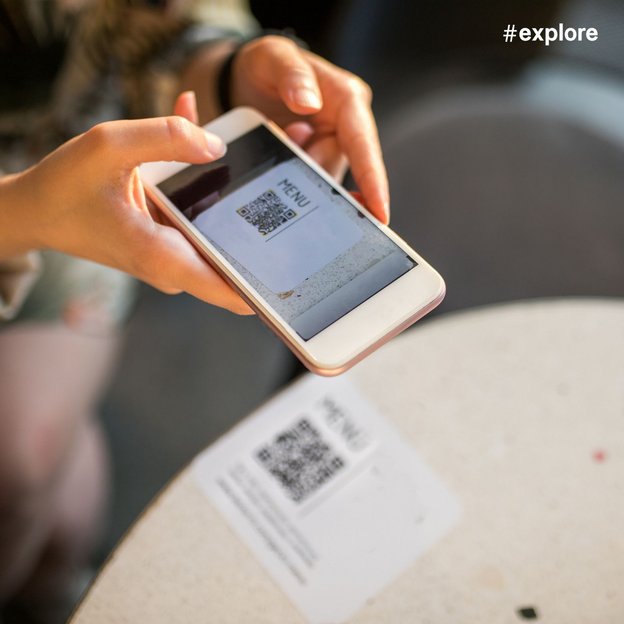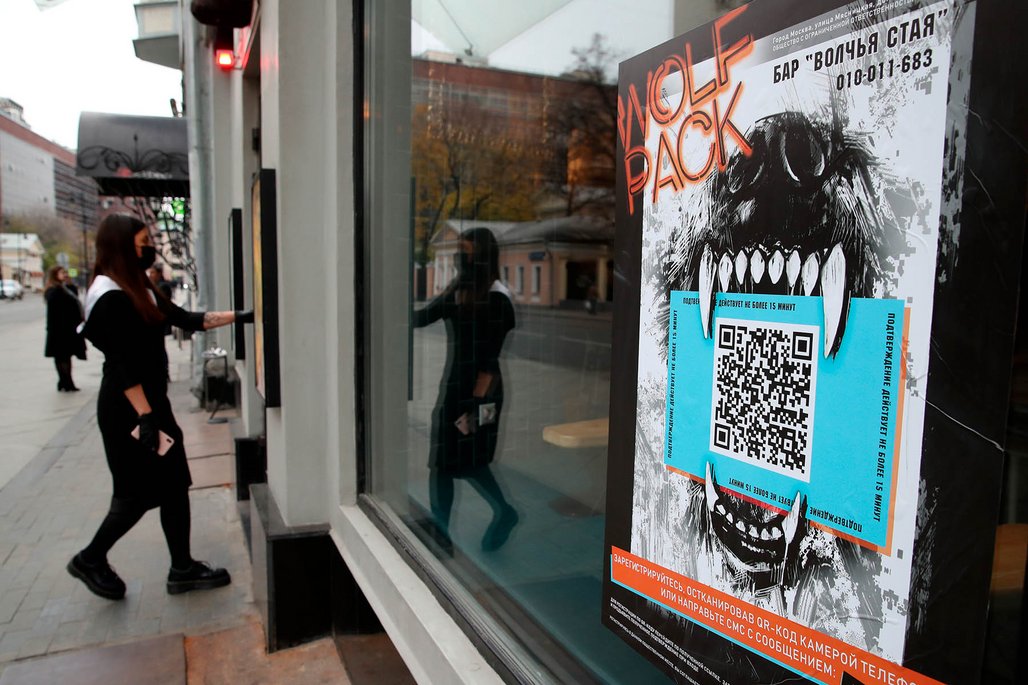Digitalisation
The Comeback of the QR Code
Why the QR code is experiencing a global renaissance during the coronavirus crisis.

Digitalisation
Why the QR code is experiencing a global renaissance during the coronavirus crisis.

November 25, 2020
In Asia, QR codes have long been part of everyday life, while in Germany (or: here), the black-and-white pixelated graphics had remained a niche technology. With the coronavirus crisis, however, the popularity of QR codes has received a significant boost on a global scale.
Masahiro Hara and his team had good reason to celebrate this October: the developers from the Japanese company Denso Wave were honored with the IEEE Milestone Award — in recognition of the global impact of the QR code, which they invented back in 1994. At the time, it was designed to help identify components more quickly in Toyota’s automobile production.
The genius of these two-dimensional, machine-readable labels lies in their design: QR codes can store around 200 times more information than a traditional barcode. They can be decoded from multiple angles and usually still work reliably even when surrounded by text or images. In fact, the data can often still be read even if nearly one-third of the code area is dirty or damaged.
QR stands for “quick response”.
However, it took considerably longer for the technology to gain global adoption.
With the advent of the smartphone, the QR code leaves the production halls and storage rooms of industry and seeps into the everyday life of the first end consumers: As the most direct link to connect the analog world with information and offers on the World Wide Web, the QR code becomes the latest craze. Just as webcams began to appear worldwide on houses and trees in the early days of the WWW, QR codes soon feel like they are everywhere—in every small town and on every milk can.
However, at the address the scanned code calls up on the internet, mostly disappointment awaits: Many websites are not yet optimized for smartphone displays, have to be awkwardly enlarged by users, and even then often only offer limited added value. In the worst case, users might even be led to manipulated pages by cybercriminals: In 2013, the Federal Office for Information Security (BSI) warned about QR codes pasted over on billboards that could lead users to fraudulent websites.
The latest craze, at least in Germany, becomes yesterday’s news, soon only making the eyes in marketing departments gleam. For most users, the pixel squares on advertising posters, street lamps, or in ads are a kind of public Op-Art: patterns without value that are mostly ignored.
Different in Asia, where the QR code is increasingly anchored in everyday life:
If you walk through a cemetery in Japan or China, you can find tombstones with QR codes attached. Holding your smartphone over the code opens a website where you can learn more about the life of the deceased. The pixel squares can be found on almost every advertising poster in Japan. Japanese authorities also rely on them: In the city of Iruma, elderly people have had mini QR-code stickers attached to their fingernails or toenails, which store an individual identification number. This makes it easier for the police to identify lost individuals. The immigration office uses QR codes with encrypted data for visas, which are attached to the passport upon entry.
In neighboring China, the QR code has meanwhile revolutionized payments. According to a study by the analytics firm eMarketer, more than 80 percent of Chinese smartphone users use their phones to pay at store checkouts. Alipay and WeChat Pay, the two largest mobile payment providers, rely on QR code technology.
The main prerequisite for the growing popularity of QR codes: their use has become easier in recent years. Previously, special apps were needed to decode the codes. Now, it is enough to simply hold the smartphone camera over the squares. And thanks to faster and more stable mobile internet, loading times no longer test users’ patience.
Die wesentliche Voraussetzung für die wachsende Beliebtheit der QR-Codes: Ihre Anwendung ist in den vergangenen Jahren einfacher geworden. Lange brauchte man spezielle Apps, um die Codes entschlüsseln zu können. Nun genügt es, die Smartphone-Kamera auf die Quadrate zu halten. Und dank schnellerem und stabilerem mobilem Internet nagt der Ladevorgang auch nicht länger am Geduldsfaden.
The Covid-19 crisis has also significantly expanded the use of the QR code worldwide. Since the outbreak of the pandemic, usage has increased by 600 percent globally, according to the marketing magazine Invidis. One thing is clear: apart from video telephony, probably no other technology has experienced such a boost this year as the QR code. And that is no coincidence: in times of contact bans and social distancing rules, the QR code proves to be the optimal contactless medium.
The code squares allow people to interact with the world around them while only touching the touchpad of their own smartphones. Instead of picking up a menu in a restaurant, the menu can simply be accessed via a QR code. With applications like ToastTab, guests can also place their orders, pay, and even tip the waiters directly.
PayPal has used the Corona crisis as an opportunity to promote cashless payments via QR code worldwide. Since mid-November, customers in the more than 8,000 stores of the drugstore chain CVS in the USA can pay contactlessly this way. Besides the large chains, PayPal particularly aims to attract small and very small businesses to contactless payments. Since May, merchants and restaurateurs in Germany have been able to display a QR code and receive money from their customers through it. Bakers, florists, kiosks, and market stall vendors could especially benefit from QR code technology, PayPal is convinced. For these small businesses, it is often too expensive to purchase a separate NFC device for contactless payments.

QR Codes Are Also Increasingly Used for Contact Tracing. In Taiwan, people register everywhere from offices to bars using QR codes. In Moscow, anyone visiting clubs, bars, or restaurants after midnight must scan such a code at the entrance. This leads either to a government app or to a page where they must enter their phone number. As a result, the authorities in the Russian capital know exactly who visited which club and when. So far, the use of these codes is mandatory between midnight and 6 a.m. Recently, McDonald’s announced that it will voluntarily introduce the system during the day in all its Moscow branches. Other fast food chains like Teremok and Chaihona plan to adopt this anti-COVID measure as well — hoping to avoid a potential closure of their locations.
Before the “light lockdown,” more and more venues in German cities also allowed guests to leave their contact details via smartphone. In Wesel, a town on the Lower Rhine, several restaurants offer the QR-code alternative to the traditional pen-and-paper method. Unlike in Russia, the data here is not sent directly to the authorities. According to the developer company based in Wesel, the information is securely stored on a server in Germany in compliance with the General Data Protection Regulation (GDPR), and is only forwarded to the health department if necessary. Students at Merseburg University of Applied Sciences can also register for lectures using a QR code.
More and more government agencies are integrating these square fields into their coronavirus measures: In Germany, COVID-19 patients can enter their positive test result into the Corona-Warn-App to automatically notify their recent contacts. Anyone traveling to Greece or Spain must register online beforehand and provide detailed information about the planned length of stay, departure airports, and accommodations. After registration, they receive a QR code, which must be shown upon entry. In Greece, failing to show this code can result in heavy fines. In Spain, travelers have their temperature checked upon arrival, and the information from the QR code is used to decide whether a precautionary COVID test is required.
Of course, contact restrictions in this country aren’t just affecting the restaurant industry, gyms, and cultural venues. For example, due to COVID-related reasons, Caritas Paderborn is taking a digital approach to fundraising this year. Instead of the usual door-to-door visits during the Advent season, volunteers in 53 communities will distribute postcards printed with QR codes. Scanning the code with a smartphone takes users to a donation page. The Catholic social organization says it wants to make it as easy as possible for donors to support local charitable projects.
Since St. Martin’s parades also had to be canceled this November due to the pandemic, the Protestant parish in the small village of Nieder-Wiesen in Rhineland-Palatinate came up with an alternative: Around St. Martin’s Day, people could follow the original parade route and scan a QR code at four different stations using their smartphone. There, they could listen to stories and songs about the kind-hearted saint, sung by the children from the “Schlaue Füchse” (Clever Foxes) kindergarten.
This is an article from #explore. #explore is a digital journey of discovery into a world that is rapidly changing. Increasing connectivity, innovative technologies, and all-encompassing digitalization are creating new things and turning the familiar upside down. However, this also brings dangers and risks: #explore shows a safe path through the connected world.